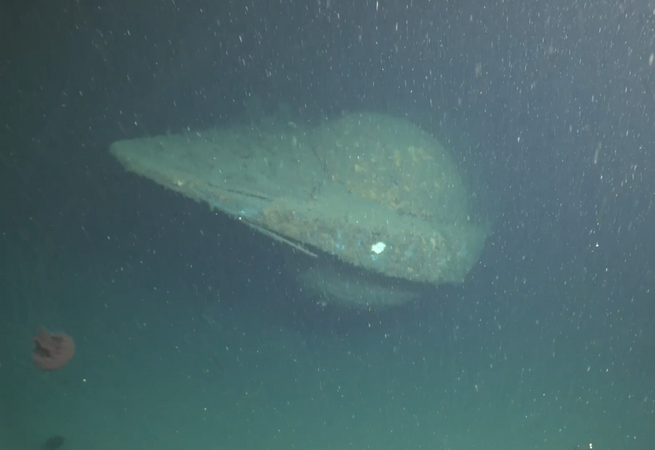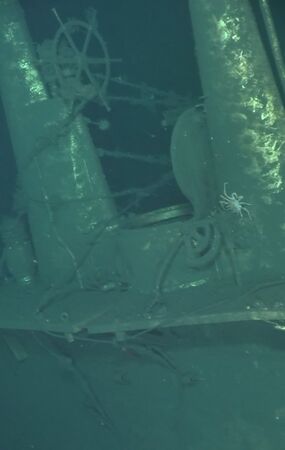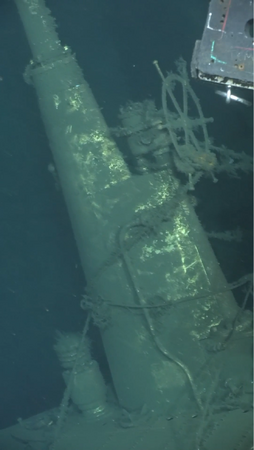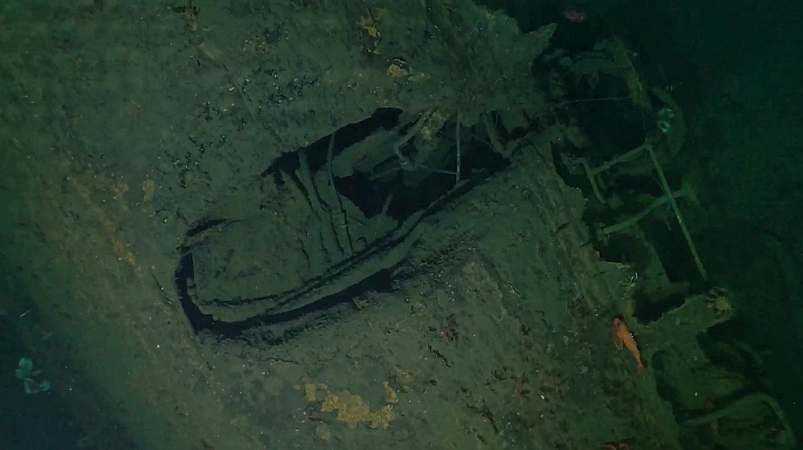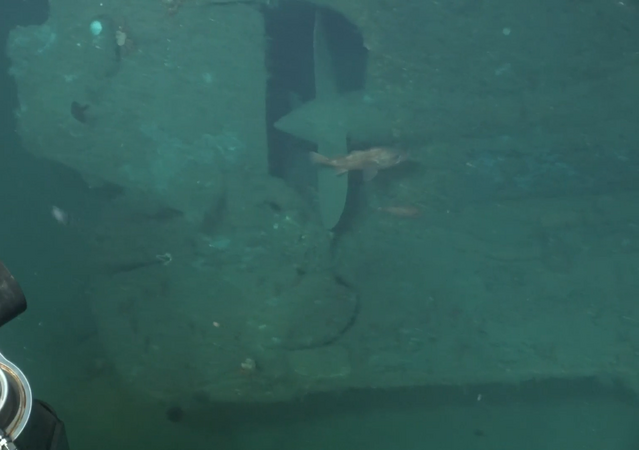F-1 collision: Difference between revisions
Pbcjohnston (talk | contribs) Added photos and captions |
Pbcjohnston (talk | contribs) |
||
| (6 intermediate revisions by the same user not shown) | |||
| Line 1: | Line 1: | ||
[[File:F- | [[File:New Header F-class.jpg]] | ||
__TOC__ | |||
==Legacy== | |||
[[File:F-1 John Peter Albert Messang.jpg|left|500px]] | |||
<div style="text-align: justify;"><span style="color:#00008B">John Peter Albert Messang seen here in a newspaper photo provided by the family (L) after the F-1 had sunk and an outtake from a larger group photo (R) of the men from the F-1 and the F-4 taken at Pearl Harbor between January and March 1915. | |||
Messang was married to Hulda Maria Klassy and had a son and a new daughter just a few months before the F-1 sinking. Messang joined the Navy in 1904 and had recently begun his fourth enlistment with the Navy at the time of the accident. | |||
His wife and family received word of his death via a telegram from Admiral L. C. Palmer from the Navy. The telegram said this; ''"The USS F-1 was rammed by another submarine at 7 p. m., Monday December 17, (1917) during a fog, the F-1 sinking immediately. It is with deepest regret that the bureau must convey to you the sad news that your husband, John P. A. Messang, Chief Machinist's Mate, was lost in the sinking of the F-1. No additional information is at hand at this time. You have the sincere sympathy of the bureau in the loss of your husband."'' | |||
The USS F-1 is the only submarine to be lost by the U.S. during World War I. | |||
<small>Photos in the private collection of Ric Hedman.</small> | |||
[[File:Red bar sub.jpg]] | |||
<div style="text-align: justify;"><span style="color:#000000"> | |||
==1986 site visit== | |||
[[File:F-1 and Avalon.jpg|left|500px]] | |||
<div style="text-align: justify;"><span style="color:#00008B">A line drawing by historian and artist Jim Christley of the F-1 laying on the bottom four nautical miles from the La Jolla Lighthouse, of the coast of California, in 1453 feet of water. This drawing shows the Deep Submergence Rescue Vehicle Avalon (DSRV-2) just above the wreck while conducting survey work in 1986. The wreck is essentially intact as the boat completely flooded before reaching collapse depth. The hole made by being rammed by the F-3 can be seen aft of the fairwater. The wreck remains to this day, just as she was found. It is a tomb for 19 good men. | |||
<small>Image scanned from "U.S. Submarines 1900-35" by Jim Christley.</small> | |||
[[File:Red bar sub.jpg]] | |||
[[File:F-1 wreck 1.jpg|left|500px]] | [[File:F-1 wreck 1.jpg|left|500px]] | ||
| Line 17: | Line 45: | ||
[[File:F-1 wreck 4.jpg|left|500px]] | [[File:F-1 wreck 4.jpg|left|500px]] | ||
<div style="text-align: justify;"><span style="color:#00008B">A haunting view of the conning tower fairwater from the port side. The open conning tower hatch can be see in the center. As the boat sank, one man was able to push himself out of the conning tower through this hatch. It was normally left open while running on the surface. On either side of the hatch are the periscope shears. | <div style="text-align: justify;"><span style="color:#00008B">A haunting view of the conning tower fairwater from the port side. The open conning tower hatch can be see in the center. As the boat sank, one man was able to push himself out of the conning tower through this hatch. It was normally left open while running on the surface. On either side of the hatch are the periscope shears. | ||
<small>USN photo courtesy of Steve Lawson of California Wreck Divers.</small> | |||
[[File:Red bar sub.jpg]] | |||
[[File:F-1 wreck 8.jpg|left|500px]] | |||
<div style="text-align: justify;"><span style="color:#00008B">Another view of the top of the conning tower fairwater, showing the open hatch. There is a small walking deck erected on both sides of the hatch. These boats had been heavily streamlined and therefore there wasn't much useable deck space when the boat was surfaced. | |||
<small>USN photo courtesy of Steve Lawson of California Wreck Divers.</small> | <small>USN photo courtesy of Steve Lawson of California Wreck Divers.</small> | ||
| Line 23: | Line 58: | ||
[[File:F-1 wreck 5.jpg|left|500px]] | [[File:F-1 wreck 5.jpg|left|500px]] | ||
<div style="text-align: justify;"><span style="color:#00008B">This is the open hatch for the | <div style="text-align: justify;"><span style="color:#00008B">This is the open hatch for the central operating compartment, which consisted of the control rooms and both battery wells. This hatch is immediately aft of the conning tower fairwater, and is seen here from the port side. Why this hatch is open is not known. It would have been normally kept shut during a surface cruise. One could speculate that it was opened by a crewman from below as the boat sank. No one successfully got out of this hatch. | ||
<small>USN photo courtesy of Steve Lawson of California Wreck Divers.</small> | <small>USN photo courtesy of Steve Lawson of California Wreck Divers.</small> | ||
| Line 37: | Line 72: | ||
[[File:F-1 wreck 7.jpg|left|500px]] | [[File:F-1 wreck 7.jpg|left|500px]] | ||
<div style="text-align: justify;"><span style="color:#00008B"> | <div style="text-align: justify;"><span style="color:#00008B">The damage done to the F-1 by the F-3. This hole is on the port side, in the forward end of the engine room, aft of the conning tower fairwater. Despite the fact that the F-boats had two internal watertight bulkheads the boat flooded and sank very quickly, likely because the watertight doors were open at the time of the collision. By the time the boat reached collapse depth it was completely flooded and therefore did not implode. | ||
<small>USN photo courtesy of Steve Lawson of California Wreck Divers.</small> | <small>USN photo courtesy of Steve Lawson of California Wreck Divers.</small> | ||
| Line 43: | Line 78: | ||
[[File:Red bar sub.jpg]] | [[File:Red bar sub.jpg]] | ||
[[File:F-1 wreck | [[File:F-1 wreck 9.jpg|left|500px]] | ||
<div style="text-align: justify;"><span style="color:#00008B"> | <div style="text-align: justify;"><span style="color:#00008B">Another view of the hole in the side of the F-1's hull. These were single hull boats and thus had no protection for the pressure hull from ramming. The force to which the F-3 hit her sister boat is evident here as the extent to which the pressure hull is stove in can be seen. | ||
<small>USN photo courtesy of Steve Lawson of California Wreck Divers.</small> | <small>USN photo courtesy of Steve Lawson of California Wreck Divers.</small> | ||
| Line 50: | Line 85: | ||
[[File:Red bar sub.jpg]] | [[File:Red bar sub.jpg]] | ||
[[File:F-1 wreck | [[File:F-1 wreck 10.jpg|left|500px]] | ||
<div style="text-align: justify;"><span style="color:#00008B"> | <div style="text-align: justify;"><span style="color:#00008B">The tip of F-1's bow, as seen by the DSRV Avalon in 1986. This view is from the starboard side. the hole for attaching the towing shackle can be seen. | ||
<small>USN photo courtesy of Steve Lawson of California Wreck Divers.</small> | <small>USN photo courtesy of Steve Lawson of California Wreck Divers.</small> | ||
| Line 57: | Line 92: | ||
[[File:Red bar sub.jpg]] | [[File:Red bar sub.jpg]] | ||
[[File:F-1 wreck | [[File:F-1 wreck 11.jpg|left|500px]] | ||
<div style="text-align: justify;"><span style="color:#00008B"> | <div style="text-align: justify;"><span style="color:#00008B">This is the aft end of the conning tower fairwater on the port side. The Allied Signal Bell can be seen at the top, along with some post-sinking corrosion induced destruction of the plating on the aft end of the fairwater. | ||
<small>USN photo courtesy of Steve Lawson of California Wreck Divers.</small> | <small>USN photo courtesy of Steve Lawson of California Wreck Divers.</small> | ||
[[File:Red bar sub.jpg]] | [[File:Red bar sub.jpg]] | ||
<div style="text-align: justify;"><span style="color:#000000"> | |||
==2025 site visit== | |||
< | <center> | ||
<gallery mode="packed" perrow=3 widths="400px" heights="300px"> | |||
File:F-1 WHOI 2025 bow.png | |||
File:F-1 WHOI 2025 bridge area.jpg | |||
File:F-1 WHOI 2025 helm.png | |||
File:F-1 WHOI 2025 hole.png | |||
File:F-1 WHOI 2025 stern.png | |||
</gallery> | |||
</center> | |||
[ | <div style="text-align: justify;"><span style="color:#00008B">In February and March of 2025 the renowned [https://www.whoi.edu/ '''Woods Hole Oceanographic Institution'''] lead a return expedition to the F-1's wreck site. Using the deep-sea submersible Alvin and the autonomous underwater vehicle (AUV) Sentry, a complete survey of the site was obtained, using both sonar and photographic data. WHOI Alvin Group manager and submersible pilot Bruce Strickrott described the experience as "amazing and an honor". It was evident that the wreck site has deteriorated over the years, with portions of the forward and aft superstructure having collapsed due to corrosion. | ||
The first photo shows the wreck from directly forward of the bow, with the prow and the rotating bow cap for the torpedo tubes clearly visible. The second and third photo are of the bridge and periscope shears, and it is apparent that this area at least is still quite intact. The surface helm wheel is quite visible. The fourth photo is a closeup of the hole in the engine room made by the F-3's prow. The fifth photo is of the port side propeller, stern planes, and rudder. | |||
<small> | <small>Images by Zoe Daheron and Bruce Strickrott. ©Woods Hole Oceanographic Institution. Used with permission.</small> | ||
[[File:Red bar sub.jpg]] | [[File:Red bar sub.jpg]] | ||
[[File:F-1 WHOI 2025 whole boat.png|left|500px]] | |||
This combined photographic and sonar photogrammetry image shows the whole wreck site. The wreck is listing far over on her starboard side, much further than the 1986 imagery suggests. As can be seen, a large portion of the forward deck has corroded away, including some features shown in the 1986 images. There is also a chunk of the aft superstructure skeg missing. | |||
Click image to enlarge. | |||
<small>Photogrammetric reconstruction by Zoe Daheron, ©Woods Hole Oceanographic Institution. Used with permission.</small> | |||
[[File:Red bar sub.jpg]] | |||
<center> | <center> | ||
Page created by:<br> | Page created by:<br> | ||
Latest revision as of 15:31, 5 June 2025
Legacy

Messang was married to Hulda Maria Klassy and had a son and a new daughter just a few months before the F-1 sinking. Messang joined the Navy in 1904 and had recently begun his fourth enlistment with the Navy at the time of the accident.
His wife and family received word of his death via a telegram from Admiral L. C. Palmer from the Navy. The telegram said this; "The USS F-1 was rammed by another submarine at 7 p. m., Monday December 17, (1917) during a fog, the F-1 sinking immediately. It is with deepest regret that the bureau must convey to you the sad news that your husband, John P. A. Messang, Chief Machinist's Mate, was lost in the sinking of the F-1. No additional information is at hand at this time. You have the sincere sympathy of the bureau in the loss of your husband."
The USS F-1 is the only submarine to be lost by the U.S. during World War I.
Photos in the private collection of Ric Hedman.
1986 site visit
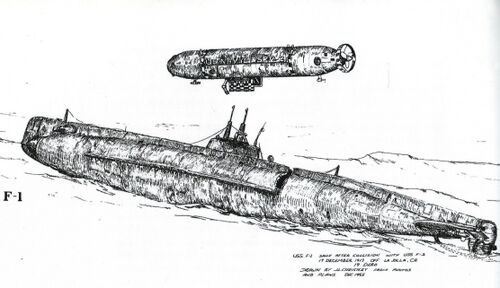
Image scanned from "U.S. Submarines 1900-35" by Jim Christley.
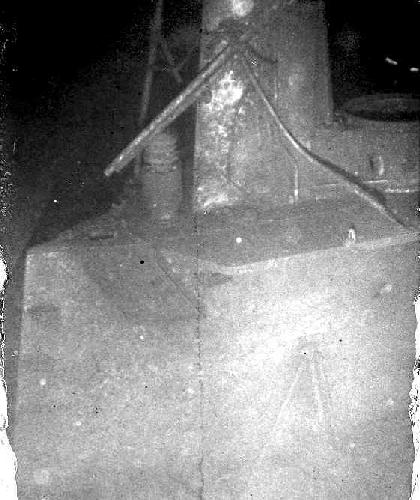
Photo provided by MMCM(SS) Rick Larson, USN, (Ret.)

USN photo courtesy of Steve Lawson of California Wreck Divers.
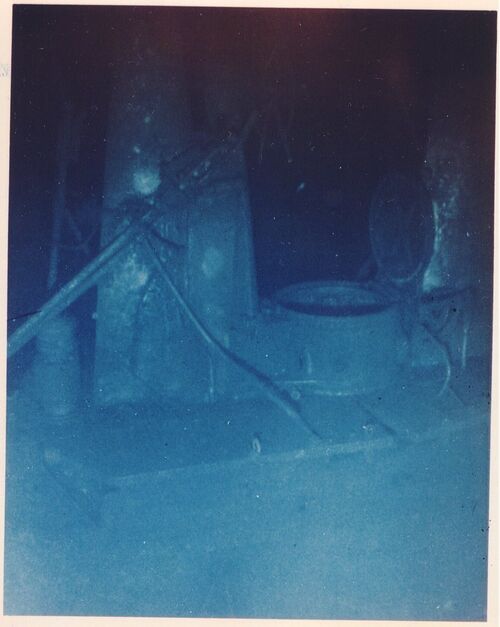
USN photo courtesy of Steve Lawson of California Wreck Divers.

USN photo courtesy of Steve Lawson of California Wreck Divers.
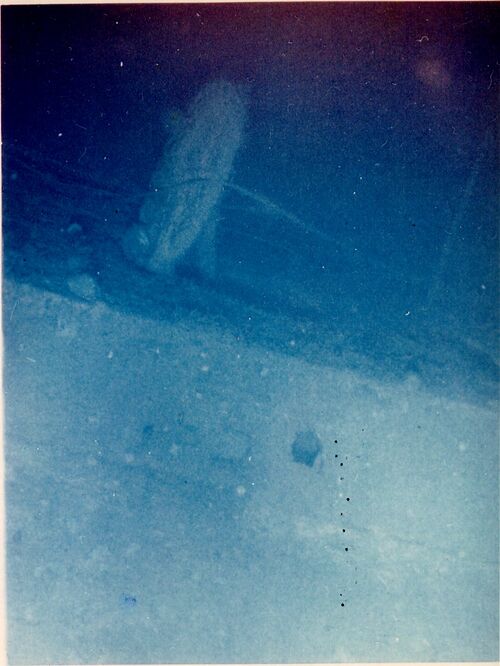
USN photo courtesy of Steve Lawson of California Wreck Divers.
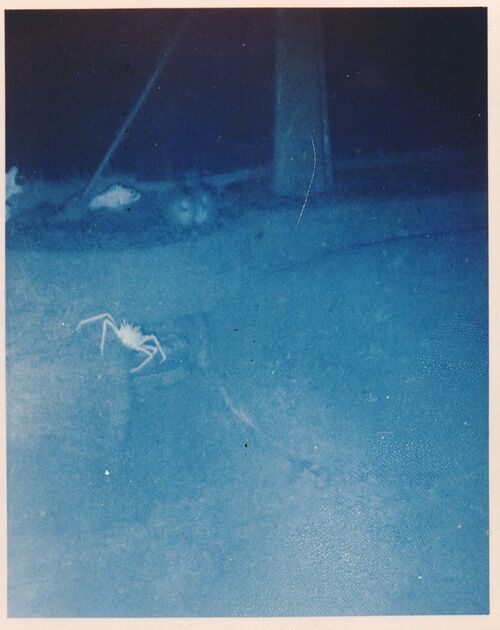
USN photo courtesy of Steve Lawson of California Wreck Divers.
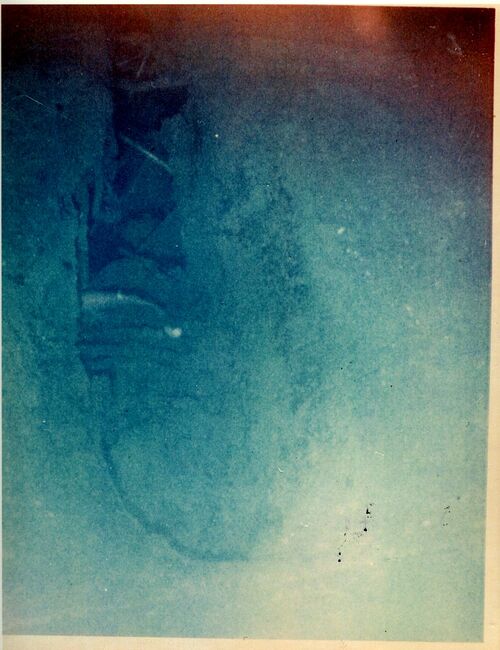
USN photo courtesy of Steve Lawson of California Wreck Divers.

USN photo courtesy of Steve Lawson of California Wreck Divers.
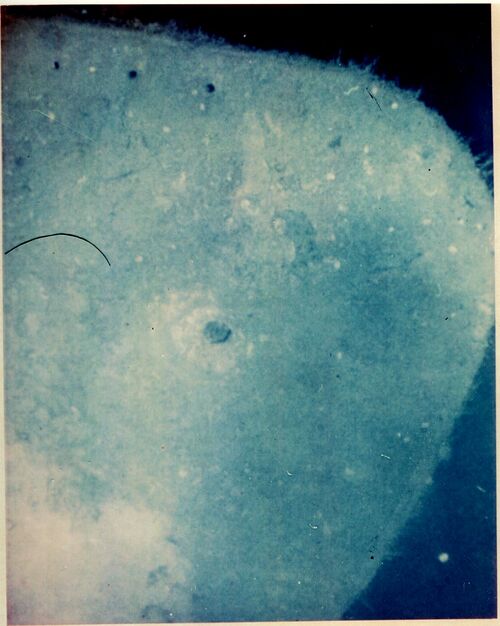
USN photo courtesy of Steve Lawson of California Wreck Divers.
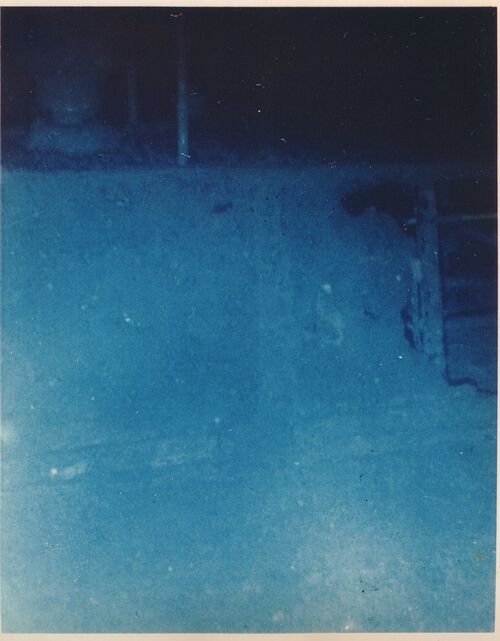
USN photo courtesy of Steve Lawson of California Wreck Divers.
2025 site visit
The first photo shows the wreck from directly forward of the bow, with the prow and the rotating bow cap for the torpedo tubes clearly visible. The second and third photo are of the bridge and periscope shears, and it is apparent that this area at least is still quite intact. The surface helm wheel is quite visible. The fourth photo is a closeup of the hole in the engine room made by the F-3's prow. The fifth photo is of the port side propeller, stern planes, and rudder.
Images by Zoe Daheron and Bruce Strickrott. ©Woods Hole Oceanographic Institution. Used with permission.
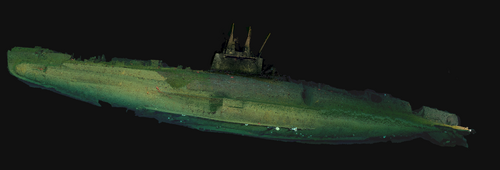
This combined photographic and sonar photogrammetry image shows the whole wreck site. The wreck is listing far over on her starboard side, much further than the 1986 imagery suggests. As can be seen, a large portion of the forward deck has corroded away, including some features shown in the 1986 images. There is also a chunk of the aft superstructure skeg missing.
Click image to enlarge.
Photogrammetric reconstruction by Zoe Daheron, ©Woods Hole Oceanographic Institution. Used with permission.
Page created by:
Ric Hedman & David Johnston
1999 - 2023 - PigBoats.COM©
Mountlake Terrace, WA, Norfolk, VA
webmaster at pigboats dot com

